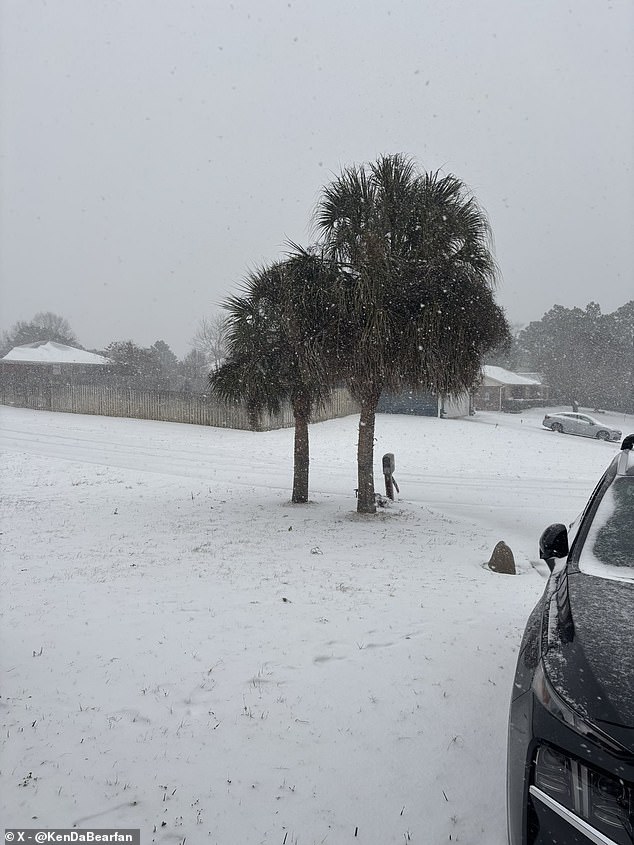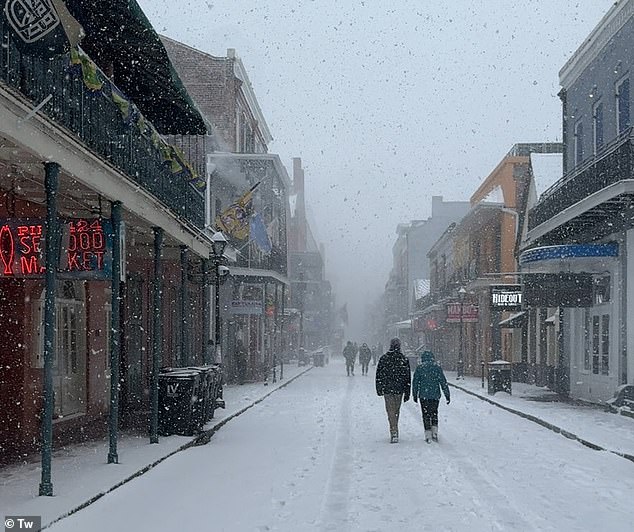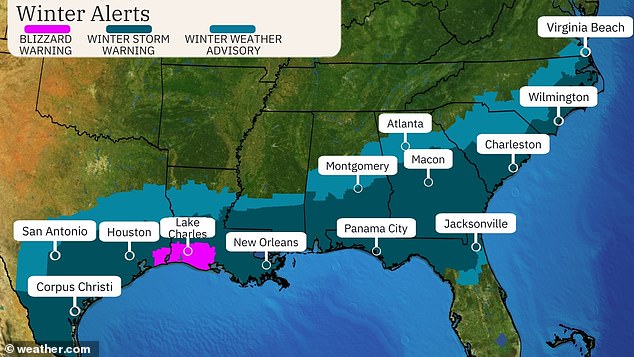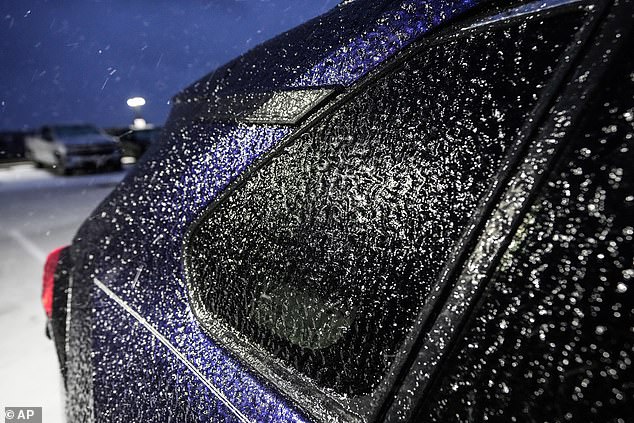A ‘historic’ snowstorm is beginning to spread snow and ice across a 1,000-mile-long stretch of the US from central Texas to northern Florida.
‘For parts of the western and northern Gulf Coast, this could be the biggest snow and ice storm in more than 100 years and possibly one that people may remember for decades,’ AccuWeather meteorologists said.
The storm threatens to shut down travel for days and cut power for an extended period in part of the region, prompting Florida governor Ron DeSantis to issue a state of emergency in 61 counties.
And it could smash records such as Florida‘s all-time-high 24-hour snowfall of four inches.
The first-ever blizzard warning was also issued for southeast Texas and south Louisiana, including the city of Lake Charles, LA where a wintry weather mix has already been reported.
As of 7am CST Tuesday, Lake Charles had already received nearly two inches of snow and could see up to four inches by 12pm CST.
Snow and ice are also quickly accumulating in Texas, including in Houston where officials have identified more than 55 areas of ice on major roadways.
The storm is predicted to track eastward across the Gulf Coast region as the day goes on, bringing snow, ice and gusty winds to southern Mississippi, southern Alabama, Georgia and the coastal Carolinas.


Winter storm warnings have been issued across a wide area that stretches from the southern portions of the Gulf Coast states to the Florida panhandle and the southeastern regions of the Carolinas.
This type of warning is issued when heavy snow is expected to fall at a rate of at least six inches in 12 hours, or at least eight inches in 24 hours, according to the NWS.
The agency placed winter weather advisories across a narrower band from southeastern and south-central Texas to the southeastern corner of Virginia.
This indicates more moderate impacts, such as a snowfall rate of three to five inches over 12 hours, a wintery mix of precipitation and/or blowing snow, the NWS states.
Major cities under alert include Houston, New Orleans, Tallahassee, parts of the Atlanta metro area and Charleston, South Carolina.
New Orleans is bracing for what could be its highest snowfall total since 1963, when 2.7 inches fell over the city. The current forecast for this area is five to eight inches.
If more than eight inches accumulate in The Big Easy, that would smash the city’s all-time snowfall record set in 1895.
City officials plan to shut down major highways, including interstates 10, 310 and 510 as road conditions worsen. Ramps to US 90 and elevated bridges will also be closed.


Houston is shutting down roads, schools and airports as one to two inches of snow had already accumulated early Tuesday morning.
Current road closures include all lanes of I-69 between FM-2218 to Harris-Ft Bend County Line, I-45 Gulf in both directions between Dixie Farm Road and I-610 South Loop.
The Houston Independent School District announced all schools would be Tuesday and Wednesday as roads have already become treacherous.
Both of the city’s largest airports — George Bush Intercontinental Airport (IAH) and William P. Hobby Airport (HOU) have suspended operations, leading to more than 1,300 flight cancellations.
In Louisiana, Lafayette Regional Airport has also cancelled all flights Tuesday due to ice and snow on the runways.


Affected areas of Mississippi, Alabama, Georgia and the Carolinas can expect one to five inches of snow today, with locally higher amounts up to eight inches in isolated areas near the coast.
Cities across this region expecting snow during include Montgomery, Alabama and Savannah, Georgia.
By Tuesday night, winter weather will taper off from the Mississippi River westward, but parts of Georgia, northern Florida and the Carolinas will continue to see snow overnight into early Wednesday.
The zone from northeast Florida to southeast Georgia may see enough ice accumulation to down tree branches and cause scattered power outages.
Winter Storm Enzo’s impact is being fueled by a polar vortex currently sweeping across the eastern half of the US.
The bitter cold hit Monday and is expected to persist through Wednesday, forcing 235 million Americans to brace for ‘life-threatening’ temperatures that could feel as low as -50F.
The Arctic air will stretch deep into the South and Southeast. States within Enzo’s path could experience feels-like temperatures of 10F to 30F, enhancing the chances of accumulating snowfall across the region.
But the cold will also impact the Midwest, the Great Lakes and New England.
Meteorologists warned that the freezing temperatures will put added stress on heating systems and the power grids, force schools to shutter and pose a high risk of frostbite, hypothermia and immune system impacts.


Much of this brutal cold will be fueled by gusty winds that can send feels-like temperatures plunging well below zero.
‘In areas that experience windy conditions, like much of the Midwest early this week, AccuWeather RealFeel Temperatures can reach minus 40 to minus 50,’ Senior Meteorologist Adam Douty said.
‘It will feel brutally cold, and anyone adventuring outside can get frostbite on exposed skin in just a matter of minutes,’ he added.
The risk of cold-related illnesses such as frostbite, hypothermia and lung or immune system impacts will be high in areas impacted by these bitterly cold winds.
Experts recommend staying indoors as much as possible when it is this cold outside. But if you do have to spend extended periods of time outside, you should take extra measures to protect yourself against the life-threatening temperatures.
That includes making sure that all of your skin is covered, wearing multiple layers of clothing and taking breaks inside to warm up whenever you can.
